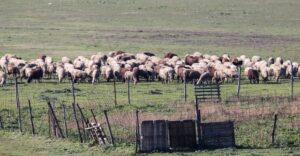In less than five months, Greece’s livestock industry has been hit hard by two severe blows: first, the spread of plague and then the sheep and goat pox, which has spread across a significant portion of the mainland. The Ministry of Agricultural Development responded quickly by prohibiting the movement of animals for slaughter, grazing, and fattening.
At the same time, livestock farmers are deeply concerned as we approach the Christmas season, and any further spread of the disease could cause enormous damage to the industry.
The decision to close slaughterhouses for sheep and goats took effect today. However, it is almost certain that after 10 days, new decisions will need to be made, allowing the resumption of slaughtering under safe conditions. Even if the Minister of Agricultural Development has announced that slaughterhouses in unaffected areas will reopen after 10 days, the key question remains: under what measures should this be done?
Five measures proposed by experts:
protothema.gr interviewed Veterinary Professor Giorgos Arsenos, who, along with Assistant Professor Athanasios Gelasakis, jointly submitted a set of proposals to the Ministry for the next steps. The two professors do not fully agree with the decision to close slaughterhouses but instead outline the steps that should be taken to restore normalcy.
More specifically, they propose:
- Ban on Animal Sales and Movement: A nationwide ban on the sale and movement of animals for breeding for the next six months, with a review of the measure at the end of this period.
- Reopening Slaughterhouses with Strict Controls: The closure of slaughterhouses for sheep and goats is deemed an ineffective measure. Instead, control, surveillance, and strict operational regulations for specific slaughterhouses in each region should be implemented. Slaughterhouses should set up infrastructure for effective disinfection of animal transport vehicles. These vehicles, rented by the slaughterhouse and compliant with transport regulations, will be disinfected upon arrival and before departure. Each vehicle should be equipped with a GPS tracking device to monitor its route in real-time. Slaughterhouses will be solely responsible for animal transportation, submitting the travel route to the Veterinary Service for verification through the vehicle’s electronic tracking data. The vehicle will always serve a single farm, load animals for slaughter, return to the slaughterhouse, and be disinfected again before making another trip. These measures will be overseen by designated regional staff members.
- Mandatory GPS Tracking for Livestock Vehicles: GPS tracking systems should be mandatory for all vehicles involved in livestock operations (e.g., milk collection trucks, feed trucks, etc.).
- Upgrading Incineration Units: Maintenance, operation, and upgrading of incineration units in selected slaughterhouses are necessary.
- Creation of a “Task Force”: The Ministry of Agricultural Development, in cooperation with regional authorities, should create a specialized task force with the sole purpose of active surveillance of farms throughout the year. This new service, under the direction of the veterinary department, will focus on continuous monitoring of livestock farms and conduct sampling based on epidemiological studies to prevent outbreaks. These teams should be well-equipped and trained, working closely with the country’s three reference laboratories.
In conclusion, while other specialized measures are also required, the urgent priority is to contain the problem without economically destroying livestock farms. The Ministry of Agricultural Development is expected to make decisions in the coming days regarding the reopening of slaughterhouses, in order to combat and eradicate sheep and goat pox without further negative consequences for the livestock sector.
Ask me anything
Explore related questions





